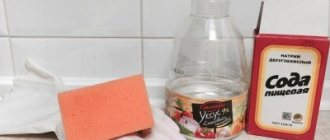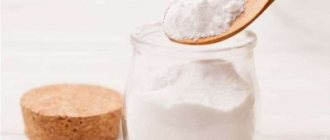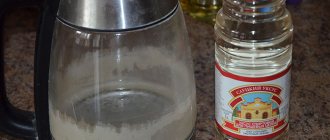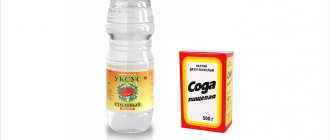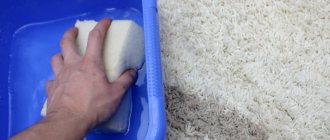Unfortunately, the toilet can become clogged. Just throw too much toilet paper at it and you're in trouble. It is worth remembering that a clogged drain will not allow water to flow through, if you continue to press the button despite the blockage, then after 3-4 drains you will expose the room to the risk of waste water overflowing and can flood the floor. Clogging can be a big problem. Although a regular plunger, in some cases, works well for clearing a drain, there are also other methods that allow you to solve the problem without special tools. How to unclog a toilet at home with a bottle, a plunger and folk remedies?
In most cases, simple remedies that are found in every home are sufficient to eliminate the problem, namely: dishwashing liquid, warm water, baking soda or vinegar. Below are methods for eliminating the problem at home using improvised means.
Liquid dish soap and warm water
The first method is to use two components:
- ordinary dishwashing liquid, which is found in every home;
- warm water.
The procedure is not complicated.
- Pour dishwashing liquid into standing water in the toilet.
- After about 20 minutes of letting the dish liquid settle to the bottom, pour a pan of warm water over the toilet paper that clogged the drain.
- After this, you should wait a little longer and drain the water.
The advantage of this home method is that it can be used in most cases. Note, however, that it is not 100% effective. Much depends on what is clogged with the drain. The method is quite effective if the passage is clogged with a paper towel. This material is slightly thicker than toilet paper and does not soften well in water, so it is a fairly common cause of clogged drains.
Unique Chinese method
Chinese and Korean industry produces a special film for cleaning toilets. If you happen to find it on sale, be sure to buy it and keep it. In case of blockages, the film can be a real salvation, because... eliminates them in a few moments.
The principle of cleaning a toilet using a film is simple to the point of genius, but it looks rather strange, since first you will have to increase (and not reduce) the blockage. This is done like this: throw crumpled toilet paper into the standing water of the bowl and flush the tank so that the toilet is filled almost to the brim.
The toilet rim is wiped dry and a special high-strength film is glued on. It should fit snugly to the rim over the entire adhesive surface so that there are not the slightest gaps or air bubbles left anywhere.
The areas where the film adheres to the toilet are carefully smoothed out. After this, water is drained from the tank several times to inflate the film, and the bubble is pushed down with smooth wave-like movements.
Some especially brave “traditional craftsmen” advise using food film instead of special film. They suggest sealing the toilet with it, drawing water and pressing on top in the same way.
This method raises great doubts, because the tightness of the cling film is questionable. In addition, it is not strong enough, so it may not withstand pressure and burst. In this case, the entire bathroom will be flooded with the contents of the toilet bowl, but the blockage will still not go away. It's better not to take risks.
How to clear a clog with a plunger
One of the most popular and simplest methods is to use a plunger.
There are quite a few types of plungers on the market, each of them is designed to clear clogged drains of different diameters. Using a plunger is a very quick and effective method, and it is also quite easy. Simply insert the rubber tip into the drain hole, push down and pull up. The tool works very simply, it acts as a suction pump and produces a pumping alternating pressure that acts on the liquid. Usually we achieve the expected effect the first time.
The only problem is that, as a rule, we simply don’t have it in stock. Therefore, it is worth purchasing this simple and inexpensive device in advance “just in case,” even if you have not yet encountered this problem.
Preventive measures
Prevention of occurrence is the following list of measures:
- Installation of new equipment must be carried out in accordance with all rules.
- It is unacceptable to throw garbage, cat litter, leftover fatty food, etc. into the toilet.
- Regular care of your plumbing fixtures and periodic cleaning will help reduce the accumulation of various deposits.
- Flushing the tank after using the toilet will allow the pipes to be flushed and will prevent sediment from accumulating.
- If it is necessary to replace pipes, the new ones must be identical in size to the old ones. Plastic is preferable to metal, as it has a smoother surface that is less prone to the formation of deposits and blockages.
- When carrying out repairs in a toilet room, the toilet lid must be lowered. This will prevent construction debris from accidentally getting inside.
- At least once a week, the toilet should be cleaned using household chemicals to prevent the formation of sediment and deposits.
Cleaning with soda and vinegar
A good way is also to combine these two components. The first of these is baking soda, which is considered the most versatile household remedy. With its help you can clean almost the entire house, it will be useful when performing activities related to cleaning windows, carpets, silverware, irons or for removing odors from shoes. In combination with vinegar, soda is an “antidote” to clogged plumbing. How to clear clogs with soda? The first step is to add a few tablespoons of baking soda to the water, then add vinegar and wait a few minutes. Then simply rinse with water.
When to turn to professionals
If none of the methods presented above provide the desired result, it is advisable to contact professional companies that specialize in solving such problems. Using modern equipment, experienced plumbers will be able to effectively deal with blockages of any complexity in a short period of time.
Turning to professionals will help you get rid of complex blockages in your sewer system.
Korean invention Pongtu
The methods listed above are successful, but there is a risk that something will go wrong and some of the collected water will overflow from the reservoir onto the floor. Pongtu is an invention from South Korea that eliminates this risk. Simply wipe the headband with a dry cloth and attach a special layer to it. Release the water, which will cause the material to bulge. Now you just need to press the bulge a few times and the plug will go away.
Removing the item
To gain access to the inside of the washing machine, first of all, you need to open the lower area of the structure where the heater is located. In some models, the heating element is located in the rear area of the machine
To do this, you need to unscrew the bolts on the back wall and carefully remove the panel. However, before carrying out all the manipulations, you need to disconnect the device from the power supply. Then you need to very carefully remove the TEN, having first unscrewed the nuts
This must be done so that in the process of searching for a foreign object, the user does not accidentally damage the integrity of the heating element. Once you have access to the hole, you can easily remove the bra wire from the washing machine
Then you need to very carefully remove the TEN, having first unscrewed the nuts. This must be done so that in the process of searching for a foreign object, the user does not accidentally damage the integrity of the heating element. Once you have access to the hole, you can easily remove the bra wire from the washing machine.
We use a rope or wire hanger
This method can be considered desperate. If you don't have baking soda and vinegar in your house, you don't have a plunger, you didn't bring back an invention called Pongtu from your trip to South Korea, and you don't even have dishwashing liquid, but maybe you can find a wire clothes hanger. It will replace the cable. You just need to unfold it and place it in the drain hole. Vigorous movements towards and away from yourself will help unblock the passage.
What remedies will not help?
There are many tips on how to clear a clogged toilet, but not all of them are effective.
- Fairy is a popular dishwashing product that easily cuts through grease, but this kind of stopper is rare in the toilet.
- Whiteness - compositions with chlorine disinfect the surface, dissolve light limescale and other deposits. They are recommended as a preventive measure against clogged drains, but they will not cope with the problem that has arisen.
- Coca-Cola or Pepsi-Cola are recommended drinks for cleaning plumbing fixtures. They can remove rust stains or alkaline deposits, but not traffic jams.
Using ineffective methods is a waste of money and time.
How to clean a toilet with a plastic bottle
If you don't have a plunger, you can make a temporary but quite effective plunger from a regular plastic mineral water bottle.
Simply cut off the bottom of the bottle and cut the plastic to a depth of about 3 cm at the bottom in a circle. The bottle cap must be screwed on and grasped with your hand. Place the cut piece in a circle into the drain hole. And then move the bottle vigorously up and down. Thanks to this, a clogged toilet can be unblocked.
A short educational program from the plumber Uncle Misha
Before leaving, Uncle Misha shared some of the wisdom of his work, which we will tell the readers of sympaty.net about. Before you choose a method for unclogging a clogged toilet, you need to figure out why the blockage occurred.
- If the toilet is clogged due to an object getting into the drain, for example, a floor rag or a bag, then it is better to use a special plumbing cable (the one that Uncle Misha came with on his shoulder). The tip of the cable is inserted into the toilet and pushed forward, rotating in a circle strictly in one direction. If compaction is felt, a push is made. Most likely, this is where a foreign object is stuck. When the blockage is cleared, you need to pour boiling water into the toilet. We didn't have to use this method.
- To remove organic waste from the toilet, it is enough to use chemicals that will dissolve the resulting blockage. This method will be effective if the toilet is clogged with food debris.
- Well, the most popular and effective way, which in most cases helps to break through a clogged toilet, is to use a plunger or a plastic bottle with the bottom cut off.
This is how Lenka and I learned some of the tricks of working as a plumber.
— Author — Yulia Spiridonova, website www.sympaty.net – Beautiful and Successful Copying of this article is prohibited!
Chemical cleaning
The problem can also be solved using appropriate chemicals. This method should be resorted to only when others have failed. It should be remembered that the funds will only enter the sewer when the water has already drained. If the water does not decrease, you need to scoop it out and then pour in a sodium hydroxide-based product. If we pour it into a large amount of standing water, firstly, it cannot work effectively, and secondly, it may cause a splash and burn us when a reaction with the water suddenly begins to occur.
If you're not afraid of this kind of work, you can do it yourself. Just remember to follow safety precautions, that is, wear gloves, goggles and appropriate clothing. If these methods do not help, then you should call a professional.
There are other remedies in the form of gel or powder or tablets that will help quickly correct the situation. Before using any product, do not forget about safety precautions and carefully read the instructions.
Removing a clogged toilet is certainly one of the least pleasant tasks that you sometimes have to do at home, and, unfortunately, it cannot be postponed until later. You may initially think that you need to call a plumber or even ask a neighbor for help, but before doing so, it is worth assessing what you can do on your own.
General principles of sewerage operation
The sewer system consists of a riser and pipelines that are designed to drain liquid waste from plumbing fixtures. The riser is a large diameter pipe and is usually located in the bathroom.
If the toilet in an apartment in a multi-storey building stops draining water due to a clog in the riser, this is a problem for all residents. Only utility workers can solve it. Special inspection niches are provided for cleaning risers
Modern risers are often made of plastic, but many houses still have cast iron pipes. The advantage of cast iron is strength, and plastic risers are less susceptible to blockages. Most often, old cast iron pipes become clogged. There are burrs on their inner walls, which causes deposits to quickly form.
To prevent air from the sewer from entering the room, a siphon is provided in the design of the toilet - a bend where a water plug (hydraulic seal) is constantly located. When flushing, water displaces and replaces this plug, pushing sewage from the toilet into the sewer riser.
When you press the button on the tank, the water drains into the bowl, washing it, and passes further through the pipe into the riser. The clog prevents the toilet from working properly and water remains in the bowl
If there is debris in the pipe and the water has not pushed it out into the riser, a clog may form. Scraps of paper, waste, hair, threads get caught on sharp or large objects. Gradually, all this turns into a large lump of dirt, which narrows or completely blocks the pipe section.


